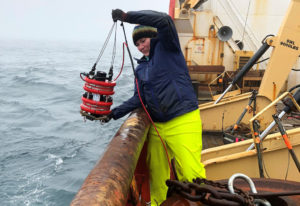
Title: The Distributed Biological Observatory (DBO): A Change Detection Array in the Pacific Arctic Region (Phase 2)
Principal Investigator: Karen Frey
Funding Agency: National Science Foundation
Within the Pacific Arctic region, the northern Bering and Chukchi Seas are among the most productive marine ecosystems. Recent shifts in seasonal sea-ice cover are having profound consequences for seasonal phytoplankton production as well as affecting intimately linked upper trophic level species, including those harvested locally for subsistence. Key uncertainties remain as to how the marine ecosystem will respond to seasonal shifts in the timing of spring sea-ice retreat and/or delays in fall sea-ice formation. The internationally coordinated Distributed Biological Observatory network provides a change detection array that allows for consistent sampling and monitoring of productivity hotspots by all participants. The overarching goal of this continuing project is to use coordinated south-to-north observations as a “space for time” strategy in which a suite of physical, biochemical, and biological measurements evaluate ecosystem change both seasonally and inter-annually over the spatially diverse latitudinal gradient. Working with collaborators from the University of Maryland, University of Washington, and Woods Hole Oceanographic Institute, specific questions for Phase 2 include:
- Will an earlier sea-ice retreat and changes in seawater properties influence the composition of pelagic and benthic prey species that can cascade to upper trophic organisms?
- How will plankton and the benthos change on the Pacific Arctic continental shelves with reduced sea-ice persistence over a south-to-north latitudinal basis, both seasonally and temporally?
- What is the impact of seasonal changes in hydrography (salinity, temperature, and nutrients) on the lateral and vertical distribution of primary production and export production to the benthos?
